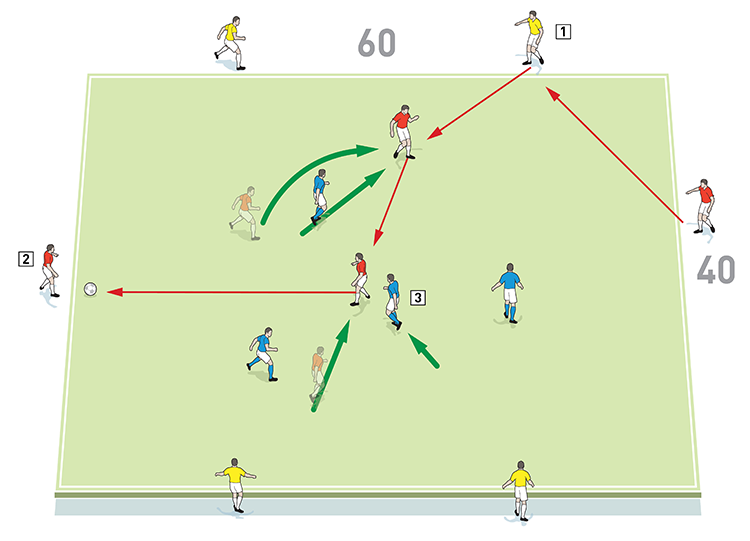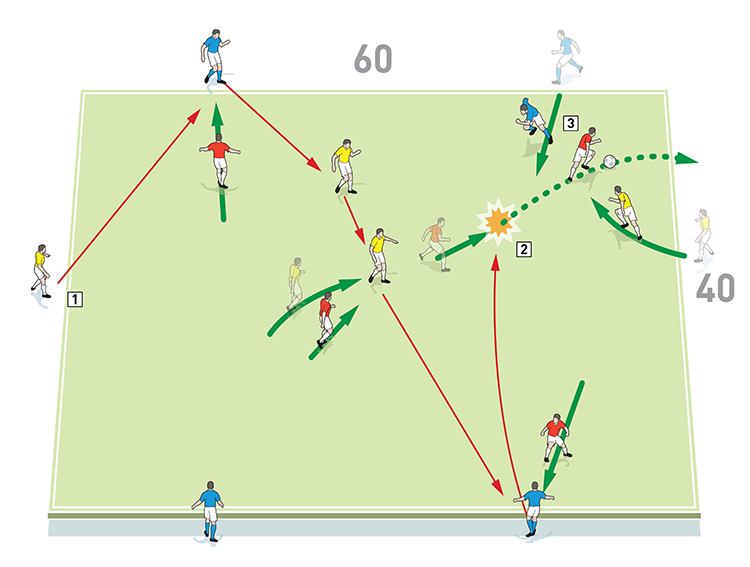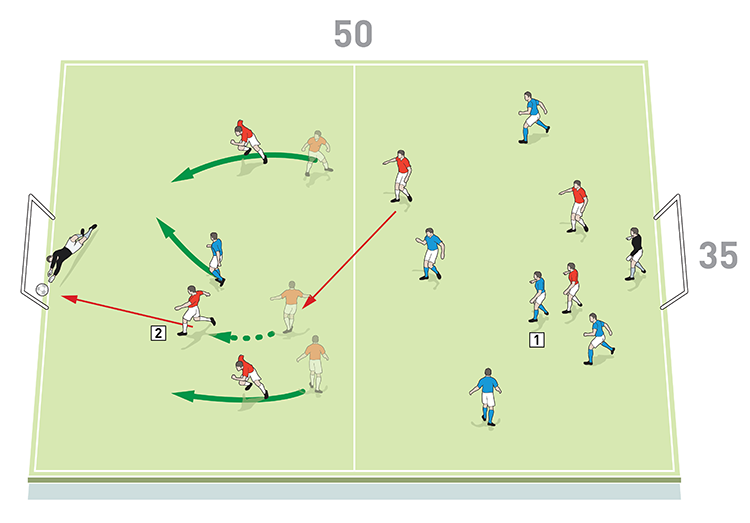You are viewing 1 of your 1 free articles
Defensive transition
With this session, we are looking to develop the player’s decision-making ability and the execution of his/her actions in the moment that possession is turned over.
| Area | Up to 60x40 yards |
| Equipment | Ball, bibs, cones, 2 goals |
| No. of Players | 12 players + 2 goalkeepers |
| Session Time |
Total: 40mins, Practice 1: 15mins, Practice 2: 25mins |
With this session, we are looking to develop the player’s decision-making ability and the execution of his/her actions in the moment that possession is turned over.
Working with the players to understand the importance of balance, both in attack and defence, are consistent themes for us as a group.
A key aspect of our balance is to create a structure where the players are in the best possible position to find solutions to the various moments that the game will inevitably bring.
One key moment is when we lose the ball – we want players to be in positions to make a decision to either regain possession immediately or recover to a defensive shape to create the right circumstances to force a regain.
In every practice we endeavour to replicate game situations. Key adjustments would be made to the format of the practice in order to encourage the type of behaviour we are looking to develop within that session.
What do I get the players to do?
Defensive transition 1
Set up an area of 60x40 yards. Split your squad into three teams of four. One team are the defenders and they press to overturn possession in the centre of the area. The other two passing teams work together to retain possession. One of the passing teams has two members on each side of the area; the third team has one member at each end and two inside the area.
The possession teams must use their position on the outside, their numerical advantage, and the support of the two inside players to keep hold of the ball. They score by either by making eight consecutive passes or by passing from one end player to the other, as shown [1a]. The pressing players must try to win the ball from the possession team – and if they do, they can score a point by dribbling the ball out of the area, as shown [1b]. However, on losing possession, the outside players can come into the area to try to regain ball. Play for 15 minutes and rotate teams every minute.
1a

2. The possession teams also score 1 point if they get the ball from one end to the other
3. The team of four defenders must press to win the ball from the possession team
1b

2. Here the red pressing team force an error and gain possession. They score a point by dribbling the ball out of the area
3. When the possession teams lose the ball, the outside players can move inside the area to try to regain the ball
Defensive transition 2
Set up an area of 50x35 yards with a goal and a goalkeeper at each end. Split your outfield players into two teams of six and play a normal 7v7 game (including keepers) with no offsides. When a team is in possession its players are free to move anywhere on the pitch, with one catch – when the team loses possession, its players are locked in the half they are in at the moment of turnover.
This mean your players must be aware of both their position on the pitch and the position of their team mates, so they can react to transitions of the ball. If teams go all out in attack and they lose the ball, as shown [2a], they will pay the penalty because they are unable to recover to a defensive position, as shown [2b]. Play for 25 minutes.
2a

2. If the attacking team loses the ball, its players must remain in the half they are in
2b

2. The reds are able to take advantage by counter-attacking with an overload
What are the key things to look out for?
We are looking for the players to consider how their position in attack can support the team in the moment we lose the ball. If we have strong connections with team mates when attacking, we will naturally have strong connections at the moment that we lose the ball.
When the ball is lost we are looking for the players to consider three key areas before selecting the best decision for the team in that moment…
1. What’s happening on ball?
• Are we in a position to apply instant pressure on the ball?
• Is the player on the ball facing his/her own goal or our goal?
• Is the player on the ball near the touchline?
2. The position of team mates
• Are we connected around the ball and able to apply immediate pressure?
• If we are not connected around the ball, can we recover defensive balance?
3. The position of opponents
• Do the opponents have connections around the ball?
• Are we in position to cover all available passes?
• Do we need to cover the space behind our defensive line and in front of our defensive line by recovering defensive balance?
What are the typical mistakes that players might make, and how do you avoid them?
The key to defensive transition is maintaining the attacking balance, or connections, to allow access to the ball when it is lost. Without attacking balance the team will not be in position to access the ball to regain it quickly, while attempting to regain the ball without access may allow the opponent to escape the initial pressure and create numerical superiority when attacking our goal with a counter-attack.
If you encourage the players behind the ball to be aware of what’s happening on the ball, and the position of their team mates and the position of their opponents, this will help ensure the team have access to the ball when it is lost, or are at least in a strong position to decide whether to press the ball or recover defensive balance.
There is often a tendency for players to retreat to their tactical position when possession is lost. But if the circumstances are right, we encourage players to “take the number off their back” and immediately apply pressure to the ball, or cover all the potential connecting passes of the opponent.
Related Files
Editor's Picks
Using the goalkeeper in build-up play
Pressing principles
Intensive boxes drill with goals
Penetrating the final third
Creating and finishing
My philosophy
Pressing initiation
Compact team movement
Defensive organisation
Coaches' Testimonials

Alan Pardew

Arsène Wenger

Brendan Rodgers

Carlos Carvalhal

José Mourinho

Jürgen Klopp

Pep Guardiola

Roy Hodgson

Sir Alex Ferguson

Steven Gerrard
Coaches' Testimonials

Gerald Kearney, Downtown Las Vegas Soccer Club

Paul Butler, Florida, USA

Rick Shields, Springboro, USA

Tony Green, Pierrefonds Titans, Quebec, Canada
Join the world's leading coaches and managers and discover for yourself one of the best kept secrets in coaching. No other training tool on the planet is written or read by the calibre of names you’ll find in Elite Soccer.
In a recent survey 92% of subscribers said Elite Soccer makes them more confident, 89% said it makes them a more effective coach and 91% said it makes them more inspired.
Get Monthly Inspiration
All the latest techniques and approaches
Since 2010 Elite Soccer has given subscribers exclusive insight into the training ground practices of the world’s best coaches. Published in partnership with the League Managers Association we have unparalleled access to the leading lights in the English leagues, as well as a host of international managers.
Elite Soccer exclusively features sessions written by the coaches themselves. There are no observed sessions and no sessions “in the style of”, just first-hand advice delivered direct to you from the coach.









